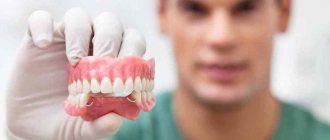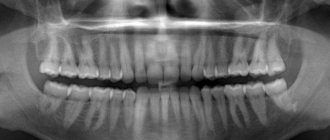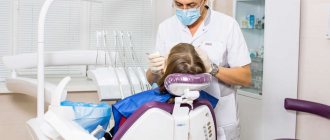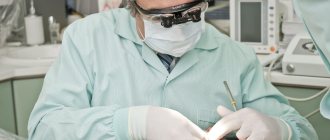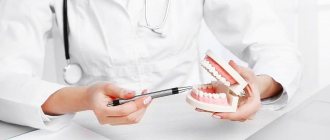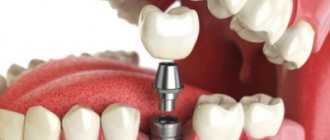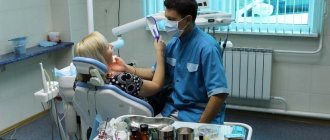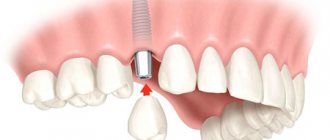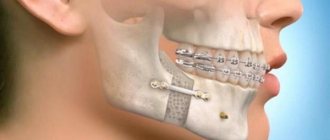Publication date: March 13, 2022.
Information on this page was updated on December 31, 2021.
TMJ dysfunction is a fairly common pathology these days, as it is largely caused by stress factors. Here it can be difficult to understand what is primary and what is secondary, because people with joint dysfunction usually come with bite pathology, pathology of the musculoskeletal system (curvature of the spine, neck). Therefore, joint treatment is a complex story. It happens that the primary pathology is a pathology of the joint, and sometimes it is the musculoskeletal system.
Comprehensive treatment of TMJ
When the doctor has determined the cause of the joint pathology, or causes, he determines the patient's readiness for a comprehensive treatment plan. In addition to the orthodontist, an osteopath or chiropractor may be involved, or even an orthopedist if more complex correction of the musculoskeletal system is required.
The patient should be aware that it is possible to straighten the jaw using a splint or splint, but this will not solve the problem of malocclusion. Orthodontic treatment will be required to correct the bite. If you have already had orthodontic treatment before, then it is more difficult to decide on repeated treatment.
Therefore, first the problem with the joint is solved using a splint or joint splint, then bite correction is carried out, and, if necessary, prosthetics. In parallel, work is underway with an osteopath to restore the muscular corset of the back and neck.
It happens that a patient refuses treatment with braces after the problem with the joint has been resolved. In this case, we warn him about the need to wear a joint splint constantly in order to avoid the recurrence of old problems with the TMJ. After all, a relapse can happen quite quickly due to stress.
Dentist-implantologist
Such a specialist is involved in treatment planning when there is a need for prosthetics.
If at the start of treatment some teeth are missing, then two tactics are considered.
- Tighten the spaces between teeth so that adjacent teeth replace the missing one. This is possible if, for example, the second molar (seven) was removed, but the third (eight, wisdom tooth) erupted. Functionally, these teeth differ little, so it is justified to move the figure eight to the place of the lost 7th tooth. But if we are talking about other teeth, then this treatment method can lead to asymmetry and an aesthetically unattractive result.
- Prepare the site for subsequent prosthetics. To do this, the teeth are not tightened, but rather, the space between them is expanded. During treatment with an orthodontist, you will have to spend some time with a noticeable gap in the row of teeth, and then contact an implantologist. This is a longer method of treatment, but the result is worth it: all the roots of the teeth will be in place, and an implant will be installed to replace the lost tooth.
This is what preparation for implantation looks like: with the help of braces, a place for the implant is prepared.
Sometimes the implantologist himself refers patients to the orthodontist. This happens if a patient applies for implantation, not knowing that malocclusion is an obstacle to prosthetics. In this case, the correct order of treatment is as follows: first correct the bite with orthodontic treatment, and only then install implants.
What may be the symptoms of TMJ dysfunction?
- Tenderness or pain in the area of one or both TMJs at rest or when opening the mouth.
- Crunching, clicking, crepitation and other noises in the area of one or both TMJs when opening the mouth.
- History of TMJ injuries (previous), incl. dislocation, subluxation, chronic subluxation.
- Restrictions in the mobility of the TMJ, restrictions in opening the mouth.
- Excessive tone of the masticatory muscles, bruxism (“grinding” of teeth in sleep, at rest).
- Asymmetry of the chin, lips, lip frenulum, asymmetry of mouth opening, S-shaped opening.
- Suspicion of a forced position of the lower jaw.
Structure of the TMJ
The presence of one or more of the above symptoms may indicate TMJ dysfunction.
Traditional orthodontic treatment does not address TMJ dysfunction. During orthodontic treatment, the severity of dysfunction may not change, decrease or increase. At the moment, in the world scientific orthodontic literature there is no convincing data on the connection between orthodontic treatment and the condition of TMJ. Deterioration of the joint after treatment may have nothing to do with this treatment.
Note! Even in the absence of visible clinical manifestations of joint dysfunction, hidden disorders may occur that require special diagnostics to identify them.
If there is a forced incorrect position of the lower jaw, its position may change during the treatment process with changes and complication of the treatment plan (the need to remove individual teeth, increasing the duration of treatment). A reliably forced position cannot be diagnosed by traditional orthodontic methods; to verify its presence, as a rule, a special analysis is required (manual functional analysis, determination of the central relationship of the jaws), the use of a special articular splint for a period of several months, which, however, does not give 100 % guarantees.
To conduct a detailed articular diagnosis, explain the specifics of your case, and further manufacture an articular splint, you can make an appointment with an orthodontist who deals with the issue of TMJ dysfunction.
TMJ dysfunction is a chronic condition that can be compensated, but not cured (i.e., it is possible to eliminate symptoms, however, pathological changes in the joints, if they have already occurred, will most likely persist).
What does a gnathologist treat?
Analyzing all existing health problems, a gnathologist determines cause-and-effect relationships between phenomena and offers optimal treatment for such diseases:
- TMJ dysfunction, articular disc displacement;
- pathological occlusion;
- bruxism or generalized abrasion.
The specialist can determine the interalveolar height (the distance between the bone ridges of the jaws), restore the correct guidance of the jaw from below and recreate the correct incisal and canine separation.
If the lower jaw constantly cramps, only a gnathologist can determine the causes of the unpleasant phenomenon and plan a course of treatment for the dental apparatus. The specialist will plan muscle relaxation therapy using splints and a disconnecting mouthguard.
What happens if TMJ dysfunction is not treated?
If the dysfunction is not treated, the compensatory capabilities of the body may sooner or later be exhausted, the symptoms will worsen, the pathology will begin to progress, causing greater discomfort (sometimes for several years), thereby affecting the deterioration of the function of the dental system.
In order to try to prevent this and carry out treatment taking into account the individual characteristics of the structure and functioning of the temporomandibular joints, patients are usually offered the following approach.
What treatment methods does a gnathologist use?
The therapy offered by a gnathologist is complex:
- To restore the correct position of the patient’s jaws, the specialist uses special joint splints. This tactic is justified if a person has bruxism, pathological tooth wear, muscle hypertonicity in the neck and maxillofacial region;
- To stimulate the masticatory muscles of the face and neck, the doctor uses a high-tech system - a deprogrammer. The development helps to deprogram the dysfunction reflex and bring the masticatory muscles to normal tone;
- in the treatment of joint dysfunction caused by poor-quality orthopedic therapy, a serious decrease in bite, the gnathologist uses an individual splint (splint) with a persistent memory effect. The device can be worn on either one or two jaws.
An individual occlusal splint not only corrects occlusion, but also copes with a number of functional tasks - evenly distributes the chewing load, reduces the activity of the masticatory muscles and corrects the direction of jaw movement from below.
Treatment method for TMJ dysfunction
1. Diagnosis of TMJ dysfunction.
- When diagnosing a joint in the clinic, a series of measurements and tests are carried out, all sensations in the joint area are recorded (discomfort, clicks, pain, deviation of the jaw when opening and closing), the difference in sensations in the right and left joint.
- The orthodontist also takes impressions of the jaws and takes photographs of the face and intraoral photographs, and also performs three-dimensional computed tomography of the face (3D CT); if necessary, the doctor can give a referral for an additional study - magnetic resonance imaging of the TMJ (MRI).
- Often, the orthodontist, in addition to manual functional analysis, conducts a visual assessment of: posture, symmetry of the shoulder girdle, shoulder blades, hip bone structures, etc., performs the necessary tests and photographs. Based on the results, it is possible to schedule a consultation with an osteopath or chiropractor to jointly manage the patient. Related specialists (orthopedist, surgeon, periodontist) can also be involved in drawing up a treatment plan.
What exercises are prescribed to patients to normalize the work and relax the masticatory muscles?
Exercise No. 1
Draw a vertical line on the mirror with a marker, stand opposite so that the line divides your face into the right and left halves, place your fingers on the area of the articular heads, lift your tongue up and back, open and close your mouth along the line (it may not work right away), 2-3 times /day 30 repetitions. There is no need to open your mouth wide (a comfortable width), the main thing is symmetrically (so that the jaw does not “move” in any direction). If there is a click, open until it clicks.
Exercise No. 2 (cycle)
Do it whenever possible, for example, in front of the TV, at the computer, or in a traffic jam while driving. Open and close your mouth without closing your teeth for 30 seconds, then alternately reach your right and left cheeks with your tongue for 30 seconds. Open - close your mouth again, then for 30 seconds move your tongue in a circle inside the vestibule (behind the lips), first in one direction, then in the other direction (clockwise - counterclockwise), open again - close your mouth, etc.. For this a half-hour cycle, the teeth should not touch, the lips should be closed. If you want to close your mouth or swallow, place your tongue between your teeth. Repeat the cycle for 20-30 minutes 2-3 times/day
When is the help of a gnathologist needed?
Experts identify a number of typical symptoms that indicate the need to see a gnathologist. Among them:
- rapid fatigue of the masticatory muscles;
- muscle hypertonicity, which is felt during chewing;
- uncontrolled jaw clenching;
- localized or isolated pain in the masticatory muscles;
- discomfort when opening and closing the mouth;
- involuntary grinding of teeth (bruxism).
The progression of dysfunction of the mandibular nerve will be indicated by such obvious symptoms as clicking in the joint (occurs when chewing, opening and closing the mouth), joint block, displacement (the mouth opens in a zigzag or S shape). In the later stages of TMJ dysfunction, the patient complains of severe pain when chewing solid foods and the inability to fully open the mouth.
With problems with TMJ, patients report headaches, migraines, and stuffy ears. With pathology, not only the masticatory muscles hurt, but also the neck and occipital area. If the joint is dysfunctional, insomnia, snoring, dry mouth, and dizziness may occur.
If the described symptoms appear, you need to make an appointment with a gnathologist as soon as possible. If you ignore the problem, the improper functioning of the joint will gradually develop into irreversible degenerative processes and arthrosis.
Occlusive therapy for TMJ dysfunction
After diagnosis, the patient is scheduled for an appointment with the orthodontist to determine the central relationship of the jaws (“true” position of the lower jaw, the position in which your joint and chewing muscles will be most comfortable).
In order to more accurately establish and fix this position, an occlusal splint (splint) will be individually made for the patient from a special plastic, which is erased as it is worn. The splint must be worn constantly (sleeping, talking, eating in it if possible) - this is the meaning of occlusion therapy, which will help the joint and masticatory muscles rebuild into the most comfortable functional state.
Cleaning and caring for the splint is very simple - after eating (as well as while brushing your teeth), brush with a soft brush with toothpaste or soap.
What is the scope of activity of a gnathologist?
Most of the unpleasant symptoms that relate to the dental system are associated with the development of diseases of the teeth and gums. However, this complex system also includes the facial and chewing muscles, jaw bones, TMJ, and nerve endings.
All of the above structural components of the dentofacial system play equally important roles in maintaining the full functioning of the dentofacial apparatus. It is the gnathologist who studies in detail the state of the constituent elements, the nature of their interaction, as well as the relationship of the structural components with other organs and systems.
The participation of a gnathologist in restorative dentistry is especially important. Unfortunately, during the restoration of lost teeth, not all clinics pay due attention to the condition of the muscles and joints of the dental system. This is why some patients, after completing restoration work, complain of discomfort when chewing, talking and smiling.
A notable feature of a gnathologist is its close relationship with other medical fields. The fact is that the science of gnathology was formed at the intersection of neurology, otolaryngology and other disciplines. A gnathologist works in tandem with orthopedists, orthodontists, and implantologists. Thanks to an integrated approach, the level of dental restoration is rapidly increasing.
Dentistry for those who love to smile
+7
Make an appointment
Installation of a brace system for a patient with TMJ dysfunction
Installation of a brace system on the upper jaw is carried out on average after 3 months of occlusion therapy. The splint is adjusted once every 1-2 weeks, or at the discretion of the doctor, until the main complaints from the TMJ are eliminated (in parallel with the alignment of the teeth in the upper jaw), then a brace system is installed on the lower jaw with partial reduction (grinding) of the interfering parts of the occlusal tires, or complete removal. Here the patient needs to be patient - the process may take several months.
At the same time, the new position of the lower jaw is monitored: repeated manual functional analysis, photometry, bite registration is possible, computed tomography of the face during treatment, continuation of orthodontic treatment with a brace system.
Upon completion of orthodontic treatment, final monitoring of the position of the lower jaw follows (manual functional analysis, photometry, bite registration, 3D CT scan of the face upon completion (after) treatment).
Joint splint
Joint splint with braces
How is diagnosis and treatment done by a gnathologist?
Treatment with a gnathologist begins with a personal conversation with the patient, during which the doctor identifies all the nuances and causes of concern. Even minor complaints can be the result of serious problems.
For a more accurate diagnosis, modern diagnostic methods are used, including hardware ones:
- computed tomography (CT) – allows you to identify pathologies of the jaw structure, assess the position of the teeth, and quickly and effectively identify any deviations from the norm;
- myography - the study of facial muscles - allows you to identify the causes of problems and discomfort when chewing;
- assessment of the condition of the muscular system and spine;
- radiography in different projections;
- visual examination of the oral cavity.
- occlusion therapy
Treatment methods are individual in each case and depend on the results of the examination and the final diagnosis. Most often, the patient is given mouth guards to relax muscles or stabilizer splints. In some cases, myogymnastics are prescribed to stimulate the formation of a correct bite and to prevent the development of complications after orthodontic treatment.
In any case, you should not refuse to visit a gnathologist, since even the slightest deviations in the functioning of the TMJ can subsequently provoke more serious diseases or the development of new ones, lead to disruption of the chewing load and, as a result, accelerate tooth wear, nullify orthodontic treatment or results prosthetics.
Forecast and prevention of joint dysfunction
The prognosis for treatment of joint dysfunction depends on the degree of pathological changes in the bone and cartilage, and the ligamentous apparatus of the TMJ.
At the initial stage of development of the disease, when there are no noticeable changes in the structure of the joint tissue, conservative treatment shows good results, which form a favorable prognosis for curing the disease.
If, at the time of seeking medical help, the patient has a significant loss of cartilage tissue, rupture or perforation of the intra-articular disc, as well as bone deformity, the prognosis is uncertain. In such cases, even after surgery to replace the articular disc, osteoplasty and other therapeutic measures, it is not always possible to fully restore the functionality of the TMJ.
Prevention of dysfunction is multifaceted. Primary preventive measures consist in the timely elimination of dental pathologies and dental anomalies. It is also worth working on existing bad habits (clenching your jaw during severe nervous tension, chewing on your hands, chewing on only one side, etc.). They stimulate the development of pathology. If the disease has developed against the background of psycho-emotional stress, it is also necessary to include psychological methods in prevention.
Secondary prevention of temporomandibular joint dysfunction involves preventing the rapid deterioration of the patient's condition and includes measures to prevent recurrent muscle spasms and the prevention of adhesions.
Ways to correct bite in children
You can change the incorrect position of your teeth in several ways:
- Hardware - individually selected plates, trainers, braces, and aligners are used.
- Orthopedic – the child wears veneers, a face mask or mouth guards.
- Surgical - the defect is eliminated through surgery.
- Training of masticatory muscles or myogymnastics.
In some cases, complex treatment is prescribed, combining two, or less often three, methods of correcting the bite.
Conservative treatment
Most cases of malocclusion are corrected conservatively, and there are seven main methods for this.
A plate for correcting malocclusion in children is a device that changes the position of teeth. Advantages:
- a sufficiently strong effect on the jaw to effectively change the bite;
- fast production - the wait does not exceed a week;
- allow for complete oral hygiene during wearing.
- are cheaper than other devices;
- Suitable for correcting open bites in children.
Negative aspects of using a plate on children’s teeth to correct their bite. The device takes up a lot of space in the oral cavity, reducing the space for the tongue, so children often play with the plates - remove them, loosen them and loosen the fastenings. Another drawback is that this method of correction worsens diction, which is especially uncomfortable for schoolchildren. The third disadvantage is a partial disruption of taste perception, since some of the receptors are covered by a plate. Fourth, the device is effective in the early stages of the problem.
The next type of conservative treatment is mouthguards for correcting malocclusion in children, also known as elastopositioners or myofunctional trainers. Made of transparent silicone, the purpose of wearing the device is to train the muscles to subsequently hold the jaw in the correct position. The main age for wearing is children 5–12 years old. Pros of trainers:
- easy to take off and put on, which provides the possibility of complete oral care;
- do not interfere with taste perception and diction;
- there is no feeling that he is undergoing treatment;
- bioinert - allergies to the material are excluded.
There are also disadvantages to wearing mouth guards. This corrective product is suitable for a responsible and obedient child who will actually wear the device on his jaw and not in his pocket. The second disadvantage is that there is less force on the jaw, so it takes more time to correct the bite of children.
Another option for correcting malocclusion is functional devices consisting of metal and plastic parts. A distinctive feature is that they do not put pressure on the jaw, the force of action is directed to the masticatory muscles. Such devices are removed before eating and brushing teeth, so the sense of taste of food and oral hygiene are not affected, but the effect depends on the regularity and time of wearing. Most of the designs are quite bulky and take up a lot of space in the mouth.
The next option for correcting your bite is braces. The design is put on six teeth - four front incisors and two large molars. Peculiarities:
- High efficiency due to strong pressure on the jaw.
- The device is applicable only to permanent teeth, therefore it is suitable for children 6–7 years old and older.
- Constant wearing. On the one hand, this is a plus - the baby cannot remove the structure, but on the other hand, food particles get clogged under the parts of the device, and oral hygiene suffers.
- The need to limit the consumption of solid food, crushing it into small pieces.
For preschool children, braces are the fastest way to correct a malocclusion. The average wearing time is two years.
For teenagers, aligners are becoming a fashion trend - transparent, individually selected aligners made of inert material. Advantages of overbite correction without braces:
- The aligners are easily removable, so eating and brushing your teeth are natural and do not pose any problems;
- the edge of the mouthguard is treated, thanks to this it does not injure the mucous membrane of the gums and lips;
- almost invisible when worn;
- there is no impact of hard metal elements on the enamel;
- high efficiency;
- relatively short treatment time - the diastema is corrected, on average, in 5 months, bilateral alignment is carried out in 12–15 months.
An orthopedic way to correct a bite is to wear veneers, which are overlays on teeth made of ceramic, porcelain, and zirconium dioxide. They are worn only on permanent teeth, so the patient’s age cannot be less than 16 years. As a rule, they require the removal of tooth tissue - grinding it down, so they are not recommended for use on healthy teeth. Veneers can be installed for 2-3 years or worn for a lifetime, requiring periodic replacement. In the long term, they lead to wearing crowns.
A relatively rare type is a face mask for correcting malocclusion in children. It is a complex device with two points of emphasis - in the frontal and chin, and less often in the buccal areas. Most often used for crowded teeth and protruding lower jaw. The strong impact on the jaws allows you to wear a face mask only at home, not to wear it to school or outside, the total wearing time is from 10 to 16 hours every day.
Treatment methods
Hardware treatment is the most effective method of treatment, since wearing it does not require daily use.
Myogymnastics is a set of exercises aimed at correcting the bite and preventing its abnormal development. Each type of disorder has its own set of movements, so it is not recommended to choose it yourself - it is better to visit a dentist and consult.
Exercises to correct a child’s bite are used for the following disorders:
- open bite;
- underdevelopment of the orbicularis oris muscle;
- oblique bite;
- lower jaw pushed forward.
In addition, special classes are used after plastic surgery of the frenulum of the tongue to strengthen the tongue muscles.
The advantages of the myogymnast are that it is effective and does not require wearing apparatus. Disadvantages of the method - it is optimally suited for children aged 4 to 7 years, it requires parental control and understanding from the child, success depends on the regularity of performing the set of exercises.
